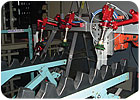
As with all robotic applications, tooling is critical to productivity. In the case of its stamping applications, DaimlerChrysler uses a variety of interchangeable end-of-arm tools and suction cups to pick up the metal sheets and transport them from one processing station to the next.
Recently, Dr. Kingman Yee, an associate professor of mechanical engineering at Lawrence Technological University (Southfield, MI), took a close look at DaimlerChrysler’s vacuum-based end effectors to see how the company could further boost efficiency. Yee was particularly interested in finding ways to reduce air consumption and downtime, as well as improve the performance and cycle time of the robots.
In the course of the study-performed as a part of DaimlerChrysler’s summer intern professors program-Yee tested a number of COAX multistage-ejector vacuum generator from PIAB U.S.A. (Hingham, MA). The vacuum generators, which are small enough to be integrated into the body of an assembler’s material-handling machinery, employ a multistage vacuum pump that creates a vacuum using compressed air.
In evaluating the ejectors on DaimlerChrysler’s production line, Yee found that they used as much as 78 percent less compressed air per cycle than less efficient single-stage vacuum generators. The COAX cartridges can also be equipped with a Vacustat check valve, which shuts off the air supply once the system has attained the correct vacuum level. According to Yee, this device can reduce compressed-air consumption by an additional 98 percent.
With COAX vacuum generators, Yee found that the cost of the electricity required to produce the compressed air for a single suction cup was about 56 cents per year, compared to approximately $62 per year per suction cup using more conventional systems. (Figures are based on an electricity cost of 7 cents per kilowatt-hour.)
For a typical DaimlerChrysler automotive stamping plant employing some 2,000 suction cups, that means a savings of approximately $122,200 per year.
In addition to being energy efficient, each COAX vacuum generator’s modular construction facilitates quick and easy maintenance, repair and replacement. Because they are light and compact, assemblers can integrate multiple cartridges into the body of a manufacturing machine, thereby creating a decentralized vacuum system in which vacuum power is positioned exactly where it is needed. This, in turn, allows a company to minimize line losses. In addition, better vacuum flow and quicker response times mean the suction cups grab quicker and hold stronger, resulting in a faster cycle times and higher productivity.
Since Yee’s initial trials, DaimlerChrysler has installed a number of COAX cartridges in its production lines. Although the company is not releasing specific figures, officials say they are happy with the results.
For more information on vacuum technology, call 800-321-7422 or visitwww.piab.com.